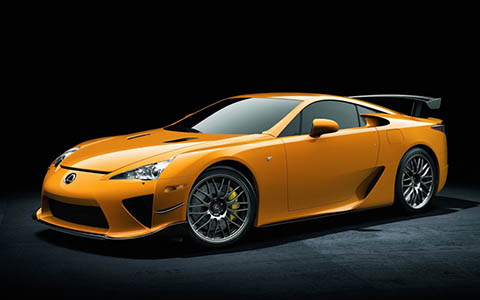When chief engineer Haruhiko Tanahashi requested a study into the viability of a real sports car, the image he had in mind bore no resemblance to the magnificent LFA that eventually went into production. After all, Lexus was a brand leader in quality passenger cars, not a manufacturer of exotic, low-volume supercars.
Four months after being given the go-ahead for the study, Tanahashi recorded in his diary that the first product meeting on June 26, 2000 proposed a V6 open-top sports car. An competitive evaluation drive at the testing facility in Shibetsu was planned for the following month. What happened at the test drive set in motion a sequence of events that would ultimately determine the design of the LFA.
Following the initial evaluation, a decision was made to produce a full-size sports car, and Tanahashi setting up a meeting with potential engine supplier, Yamaha, to discuss possible options. Tanahashi discussed both V6 and V8 engines with his counterparts at Yamaha and studied the options with the intention of presenting them at the next product planning meeting. In September 2000, he met with Toyota’s Executive Vice President Mitsuhisa Kato, who made it clear that a V8 would not be adequate to power the dream car. Only a V10 that could rival Formula One technology would be seen as appropriate for a Lexus supercar!
Engine
The V10 design held several advantages over other equivalent displacement layouts: V8 wouldn’t be able to rev as high whilst the reciprocating mass and increased friction of a V12 would eat away at performance.
The 4.8-liter engine in the LFA was designed to produce 412 kW (560 PS) at 8,700 rpm, with a maximum torque of 480 Nm (354 lb.ft) at 6,800 rpm, 90 percent of which would be available from 3,700 rpm. The engine had to rev to 9,000 rpm, with the fuel cutoff set at 9,500 rpm. Forged aluminum pistons, forged titanium connecting rods, and solid titanium valves were chosen for durability and reliability.
The design of the V10 allowed for an incredibly quick throttle response – the LFA engine can rev from idle to 9,000 RPM in 0,6 seconds. To ensure sufficient air supply, intake air had to be fed directly from beneath the hood into a dual stage variable intake manifold through ten separate throttle bodies for instantaneous response. The response was so fast, that a specially designed digital TFT LCD rev counter was used just to keep up!
The production engine, carrying the designation 1LR-GUE had an included bank angle of 72-degrees which allowed for even distribution of the combustion forces without using a split-journal crankshaft, thus improving engine efficiency as well as lowering overall weight. Dry sump lubrication was chosen, not only to prevent engine oil starvation during high speed cornering, but also to lower the engine’s center of mass. Even though the exact weight of the engine has never been officially revealed, it is rumored to weigh less than the 3.5-liter 2GR-FE V6 engine.
Powertrain
Tanahashi chose a front mid-engine/rear transaxle powertrain layout instead of a mid-engine configuration, to be inherently more forgiving; allowing less experienced drivers a wider safety margin.
With the focus on optimizing weight distribution, the 73 L (19 US gal) fuel tank was mounted ahead of the rear axle, straddling the exhaust system, with the radiators mounted aft of the axle.
Drive to the transaxle was accomplished through a rigid carbon-fiber torque tube with the exhaust system running directly below. This stacked driveshaft and exhaust arrangement decreased the width of the tunnel allowing for centrally located seating.
Chassis
To further reduce weight, the original aluminium alloy chassis was redesigned to be produced in-house as a carbon fiber reinforced polymer (CFRP) tub, with bolt-on aluminum front and rear subframes. The subframes, which minimized potential repair costs, were joined to the monocoque using a unique aluminum flanged-collar design for maximum strength.
65% of the vehicle’s total body mass is CFRP, while the remaining 35% is aluminium, saving 100 kg (220 lbs) over the original aluminum design.
Gear
In keeping with best design practices, the front suspension makes use of a double-wishbone arrangement, while the rear suspension is a multi-link with coil-over dampers on all four corners. The dampers are monotube with a remote fluid reservoir that includes an expanding and contracting bellows to overcome any aeration of the dampening fluid.
To scrub off speed from the 202 mph that the LFA was designed for, Brembo monobloc brake calipers were specified: six-piston up front and four-piston at the rear. These act through 390 mm (15.4 in) front and 360 mm (14.2 in) rear carbon ceramic disc rotors controlled by Toyota’s Electronically Controlled Brake brake-by-wire system.
To squeeze in the brake rotors and calipers and ensure traction in all conditions, Tanahashi decided to fit forged 20-inch BBS wheels shod with 265 mm front and 305 mm rear Bridgestone Potenza tires as standard.
The LFA had to be safe in the hands of drivers of varying skills levels, so the design team engineered a three-mode Vehicle Dynamics Integrated Management (VDIM) stability control system with a Sport setting to compliment all skill levels.
Taking a supercar from concept to final design is a task that even dedicated low-volume specialist manufacturers find daunting. For Haruhiko Tanahashi and his team, overcoming the challenge of completing the award-winning LFA design is an accomplishment that has carved out well-deserved space for them in the annals of motoring history.
